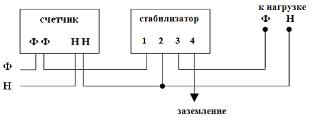Categories: Featured Articles » Electrician at home
Number of views: 156369
Comments on the article: 12
How to choose a voltage stabilizer for a country house
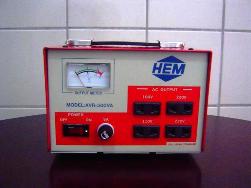 Long gone are the days when mains voltage was more or less stable, and was equal to 220 V + - 3-5%. In the realities of today's life.
Long gone are the days when mains voltage was more or less stable, and was equal to 220 V + - 3-5%. In the realities of today's life.
The voltage, depending on the region of residence, can fluctuate in very large limits. Anyone who is even a little familiar with power grids knows that the further the facility, in this case your house, is from the transformer substation, the greater the voltage drop.
The employees of the organization that distributes electricity, most of which is RES, regulate the output voltage on the transformers so that at the midpoint it (voltage) is 220 V.
As a result, if the power line is quite long, and there are relatively many consumers, then near the substation the voltage will be an order of magnitude higher than the nominal, and at the other end of the power transmission line the voltage will be underestimated. In both cases, for most electrical appliances, both overstated and understated voltage are dangerous; many electrical appliances will simply not turn on or fail.
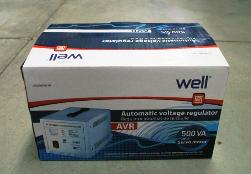 Only devices capable of regulating voltage can help in this situation. Such devices are called - Surge Protectors.
Only devices capable of regulating voltage can help in this situation. Such devices are called - Surge Protectors.
We will try to figure out how to choose the right stabilizer, what power it is necessary to choose a stabilizer for it to work reliably, and not overpay for extra kilowatts, the amount of which directly affects the cost of the device.
So, for starters, let's determine what stabilizers are, an approximate principle of operation of this device itself. For the most part, all stabilizers work approximately the same. Depending on the voltage in the network, the electronic filling of the stabilizer controls and switches the turns of the transformer, thereby regulating the output voltage.
Types of voltage stabilizers
To date, the most popular can be called the three main types of stabilizers, more precisely the three principles of voltage regulation - servo-stabilizers, relay stabilizers and electronic stabilizers.
IN servo stabilizers regulation of the output voltage occurs due to a change in the number of turns on the transformer. The actuator in this type of stabilizer is a servo-driven motor that “drives” the runner through the turns of the transformer.
The positive side of stabilizers of this class is their relatively low cost. Since there are many mechanical components in such stabilizers, their reliability is far from ideal.
One of the most common failures is sticking of the carbon-graphite assembly and failure of the servo-drive mechanism. In terms of reliability, such stabilizers are much inferior to stabilizers of relay and electronic types.
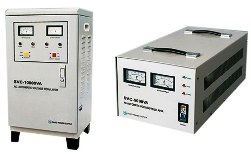 Relay voltage regulators. This, so to speak, is the middle segment between servo-driven and electronic stabilizers. In these stabilizers, the executive switching mechanism is a block of power relays, which switch the transformer windings.
Relay voltage regulators. This, so to speak, is the middle segment between servo-driven and electronic stabilizers. In these stabilizers, the executive switching mechanism is a block of power relays, which switch the transformer windings.
Relay stabilizers have the advantage of a relatively low cost, as is the case with servo-driven transformers. And since mechanical parts-relays are also present here, the service life of such stabilizers is also limited.
One of the common causes of failure of relay stabilizers is sticking of relay contacts. The average number of trips of a relay is about 40,000 times. About an average number of times an average relay performs in 300-500 working days, it all depends on the quality of the electricity in your network.
Electronic voltage regulators. These stabilizers are perhaps the most reliable and durable devices for voltage stabilization. The executive mechanism in this case are electronic thyristor switches, triacs …
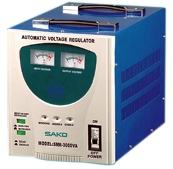 The advantages of electronic stabilizers include: reliability, speed, response time to a change in input voltage of 20-30 ms, silent operation, which is important if the stabilizer is located in a residential building. The only drawback of these devices can be called their cost. Such stabilizers are approximately twice as expensive as their mechanical counterparts.
The advantages of electronic stabilizers include: reliability, speed, response time to a change in input voltage of 20-30 ms, silent operation, which is important if the stabilizer is located in a residential building. The only drawback of these devices can be called their cost. Such stabilizers are approximately twice as expensive as their mechanical counterparts.
Now we need to calculate the power that the voltage regulator can withstand. Before you start counting watts, a little theory on electrical engineering.
Many of you probably noticed that on the nameplates of the devices or in the passport for the same devices, the power in Watts (W) or Watt-Amperes (VA) is often written. The fact is that for the CORRECT calculation we need to take into account the FULL (VA) power of electrical appliances. Full power consists of active and reactive energy. When the power in W is written on the devices, it indicates the ACTIVE (W) power.
Also, when calculating the power of the stabilizer, it is necessary to take into account the presence of electric motors. The fact is that electric motors at the time of start-up consume 3-6 times more current than during normal operation. This is especially true for pumps, compressors, refrigerators.
Another important detail is the inclusion of the transformation coefficient, that is, if the voltage "dropped" by 20%, then, therefore, the power of the stabilizer also decreased by 20%. So it is not quite right to take the stabilizer right up to the mark, it is necessary to give a margin of 20-30%.
In any case, before making a purchase, invite a QUALIFIED specialist for accurate measurements.
Connection diagram of a voltage stabilizer for a country house
Connect the stabilizer, if it is designed to provide stabilized voltage to the entire house, it is best immediately after the meter, approximately as in the picture. You can connect the stabilizer yourself, but it is better to entrust the connection of the stabilizer to a professional, he will do it faster and better.
See also at electro-en.tomathouse.com
:

